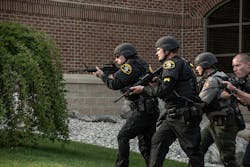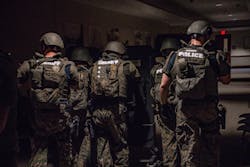Responding to active shooter attacks has been a hot topic, not only for law enforcement but for the entire community. Any community. There are still plenty of places where the general thought is, “It can’t happen here,” and they are severely deluding themselves.
Changing that mindset can be key to being prepared. Part of that preparation includes law enforcement discussing basic response protocols and the equipment necessary to enact them. There are also some equipment schools can keep on hand, sometimes in each classroom, to help reduce or remove the casualty count created by an active shooter.
Let’s start out with the responding officers
Every officer on the street today should be wearing body armor capable of stopping the issued duty ammo. That means most of the armor should be Level IIIA or III+. This armor is not rated to stop most rifle caliber ammunition. The only way to really increase this ammo-stopping capability is to add hard armor/trauma plates to what is already normally worn. A plate-carrier platform not only allows the officer to increase the threat protection of the body armor he’s wearing as he enters a high risk scenario, but it also offers a platform on which to carry other necessary equipment, and one that is easy to grab/don quickly.On that platform, or in a grab-bag, should be, at a minimum, several items in whatever quantity can be managed. While many officers want to carry extra ammunition, and there is certainly no reason not to, historical reference would dictate that we carry trauma care supplies as the priority. Additionally, after the events at Virginia Tech where Seung Hui Cho chained several doors shut to prolong the amount of time he’d have before law enforcement could gain access and terminate his attack, breaching equipment is also a consideration.
First and foremost we see a need to carry supplies to treat casualties. Injuries to extremities are the easiest to treat with either a pressure bandage, a hemostatic agent, or a tourniquet or a combination thereof. How many of each is enough? As many as you can carry without the load being overly burdensome. Using Virginia Tech as the example, with over 50 casualties in Norris Hall, if each responding officer had two tourniquets, then there would have been more than needed (potentially). Every officer should be carrying a tourniquet for himself anyway, so carrying one extra in a response kit (on that plate carrier platform) isn’t a big deal. Carrying two more makes treatment capability that much better. Add in some hemostatic gauze (QuickClot, Rapid, etc.) and a pressure bandage (SWAT-T, Israeli bandage, etc.) and your ability to assist/treat casualties after the attacker has been neutralized is greatly expanded. After neutralizing the shooter, providing emergency trauma care is the most effective way to save lives in the event of an active shooter attack.
Before we can neutralize a shooter or treat casualties we have to get to them. As mentioned, at Virginia Tech the shooter had chained several doors shut and a means of gaining entry—of breaching the door—was required. Bolt cutters are neither expensive nor heavy, and carriers for MOLLE platforms are available. With that one simple tool most officers can gain access through a door that is chained shut by cutting the chain or the padlock securing it. Gaining access and making entry in a timely fashion is the single most important factor in any response. We can’t do anything effective until we are on scene and in the case of active shooters, “on scene” doesn’t mean on the property; it means inside the area where the active shooter is hunting. We have to gain access and do it quickly.
Inside the classroom
Inside the school, every classroom should be equipped with a good first aid kit (to include the items mentioned above) and a means of securing the door beyond the deadbolt. Locks can be shot out. Is there another way to secure the door? If the door opens into the room, then a simple door stopper is an effective means of stopping or slowing down a bad actor from gaining entry. Another method may be a piece of strong cord that ties the doorknob to something else anchored on the wall to keep the door from opening, even if it’s not locked. Something to cover any window(s) in the door and write on the outside windows (so the responding officers have information about who is in the room, how many, wounded, etc.) should be mandatory.
With some minimal but effective and realistic preparation, the response to active shooter attacks can be increased to the point of denying the shooter very many targets, thereby minimizing potential casualties.
This article is part of a series of articles dedicated to responding to and prevention of active shooter events. Download and share the entire series here.


